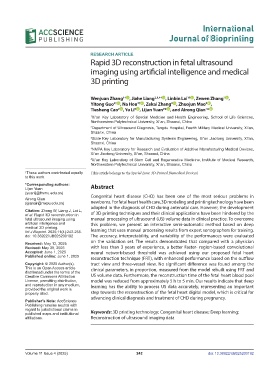Page 250 - v11i4
P. 250
International
Journal of Bioprinting
RESEARCH ARTICLE
Rapid 3D reconstruction in fetal ultrasound
imaging using artificial intelligence and medical
3D printing
Wenjuan Zhang 1† id , Jiahe Liang 2,3,4† id , Linbin Lai 1† id , Zewen Zhang 1 id ,
Yitong Guo 2† id , Na Hou 2† id , Zekai Zhang 2 id , Zhuojun Mao 2 id ,
Tiesheng Cao 2 id , Yu Li 5 id , Lijun Yuan * , and Airong Qian *
1 id
2 id
1 Xi’an Key Laboratory of Special Medicine and Health Engineering, School of Life Sciences,
Northwestern Polytechnical University, Xi’an, Shaanxi, China
2 Department of Ultrasound Diagnosis, Tangdu Hospital, Fourth Military Medical University, Xi’an,
Shaanxi, China
3
State Key Laboratory for Manufacturing Systems Engineering, Xi’an Jiaotong University, Xi’an,
Shaanxi, China
4 NMPA Key Laboratory for Research and Evaluation of Additive Manufacturing Medical Devices,
Xi’an Jiaotong University, Xi’an, Shaanxi, China
5 Xi’an Key Laboratory of Stem Cell and Regenerative Medicine, Institute of Medical Research,
Northwestern Polytechnical University, Xi’an, Shaanxi, China
† These authors contributed equally (This article belongs to the Special Issue: 3D-Printed Biomedical Devices)
to this work.
*Corresponding authors: Abstract
Lijun Yuan
(yuanlj@fmmu.edu.cn) Congenital heart disease (CHD) has been one of the most serious problems in
Airong Qian
(qianair@nwpu.edu.cn) newborns. For fetal heart health care, 3D modeling and printing technology have been
adopted in the diagnosis of CHD during antenatal care. However, the development
Citation: Zhang W, Liang J, Lai L,
et al. Rapid 3D reconstruction in of 3D printing techniques and their clinical applications have been hindered by the
fetal ultrasound imaging using manual processing of ultrasound (US) volume data in clinical practice. To overcome
artificial intelligence and this problem, we present an interactive semi-automatic method based on deep
medical 3D printing.
Int J Bioprint. 2025;11(4):242-255. learning that uses manual processing results from expert sonographers for training.
doi: 10.36922/IJB025200192 The accuracy, interpretability, and variability of the performances were evaluated
on the validation set. The results demonstrated that compared with a physician
Received: May 12, 2025
Revised: May 30, 2025 with less than 3 years of experience, a better Faster- region-based convolutional
Accepted: June 1, 2025 neural network-based threshold was achieved using our proposed fetal heart
Published online: June 1, 2025
reconstruction technique (FRT), with enhanced performance based on the outflow
Copyright: © 2025 Author(s). tract view and three-vessel view. No significant difference was found among the
This is an Open Access article clinical parameters, in proportion, measured from the model rebuilt using FRT and
distributed under the terms of the
Creative Commons Attribution US volume data. Furthermore, the reconstruction time of the fetal heart blood pool
License, permitting distribution, model was reduced from approximately 5 h to 5 min. Our results indicate that deep
and reproduction in any medium, learning has the ability to process US data accurately, representing an important
provided the original work is
properly cited. step towards the reconstruction of the fetal heart digital model, which is critical for
advancing clinical diagnosis and treatment of CHD during pregnancy.
Publisher’s Note: AccScience
Publishing remains neutral with
regard to jurisdictional claims in
published maps and institutional Keywords: 3D printing technology; Congenital heart disease; Deep learning;
affiliations. Reconstruction of ultrasound imaging data
Volume 11 Issue 4 (2025) 242 doi: 10.36922/IJB025200192

